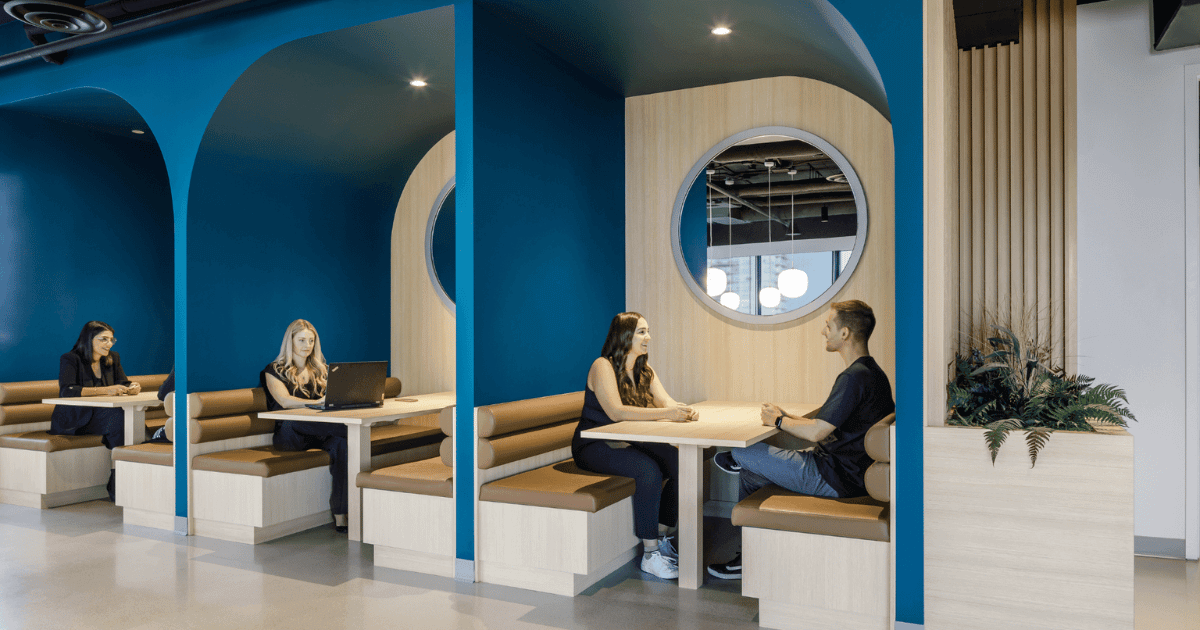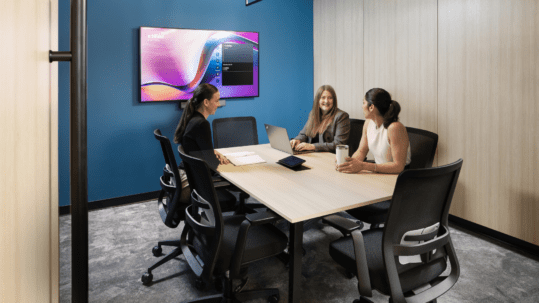Is your office environment worth leaving the house?
In today’s rapidly evolving work landscape, employees have come to expect more from their workplaces. Lacklustre offices lined with cubicles and a few coveted private offices will no longer be welcomed or accepted. As a result, businesses must adapt and create a commute-worthy workplace that goes beyond the basics. Companies must focus on designing workplaces dedicated to improving the employee experience, making the commute worth it. Continue reading to learn solutions companies can implement to enhance the employee experience, enticing staff to make the commute and select the office as their primary place of work.
Three strategies to design a commute-worthy workplace.
Unlock new innovative and distinctive workspace solutions designed to motivate and inspire employees, compelling your workforce to embrace the return to work. Here is our list of three commute-worthy workplace solutions to include in your next redesign:
Various work settings
When working remotely, employees have numerous options for where to work, ranging from their home workstation to a coffee shop. Exploring different environments provides a new dimension to the work experience, providing an escape from the confines of a traditional desk. To compete with this experience, companies can offer various work environments within the workplace. The availability of these different spaces ensures that employees have the freedom to choose the most suitable environment for the tasks at hand on any given day. Having highly optimized and various areas within the office that allow staff to get their work done more effectively than they would at home allows for a more enjoyable work experience. This flexibility may increase employees’ likelihood of choosing the workplace as their primary work destination. In contrast, if all they are offered is a chair and desk in a crowded office, they may decide to stay home.
Different types of work environments to include within the workspace:
- Open Workstations– provide a collaborative environment, fostering teamwork and idea-sharing among staff.
- Private Desks– offer a sense of privacy and focus, allowing individuals to concentrate on solo work.
- Meeting Rooms– facilitate formal discussions, brainstorming sessions, presentations, and decision-making.
- Office Pods and Phone Booths– provide secluded areas for quiet work or confidential conversations.
- Acoustic Alcoves– serve as retreats from distractions, enabling employees to recharge.
- Informal Seating Areas– offer a more relaxed and comfortable area for casual discussions and impromptu meetings.
- Open Workstation
- Private Offices
- Meeting Rooms
- Informal Meeting Areas
Providing the comforts of home and more
What entices employees to work from home? A part of it is the flexibility remote work provides; another part is the extra time available within a day; some experts suggest that working at home offers a more comforting and relaxing work atmosphere. When individuals feel at ease during the working day, they are more productive, less stressed, and can more efficiently complete tasks. By incorporating elements that evoke a sense of relaxation and personalization, employees are more likely to feel at ease. For example, companies can add comfortable and ergonomic furniture that mimics the feeling of home, such as plush seating and lounge furniture. Additionally, introducing natural lighting, soothing colour themes, and biophilia can create a calming atmosphere similar to the home environment.
State-of-the-art amenities
Amenities are crucial in attracting employees to the office by creating an engaging and vibrant workplace. Companies can invest in state-of-the-art technology and modern amenities that promote productivity and make the office desirable. Integrating amenities within the work environment demonstrates to staff a corporate commitment to providing a modern and innovative workspace. Furthermore, amenities help to enhance productivity, collaboration, and employee satisfaction. This, in turn, boosts morale, strengthens company culture, and ultimately helps attract staff back to the office.
Different types of amenities to include within the workspace:
- Fitness Center- offers employees the convenience of onsite workouts, promoting a healthy lifestyle and reducing stress.
- Yoga studio/ Wellness room- provides a serene space for mindfulness and relaxation, allowing individuals to recharge.
- Café Area- fosters social interactions, encouraging networking and collaboration among colleagues.
- Training Rooms- employee training rooms give employees more space for onsite career development training.
- Game Room- allows employees a fun and collaborative area to break away from the stress of work.
- Patio/ Outdoor Event Area- provides a space for employees to enjoy the outdoors and access natural daylight, which helps with wellness. It also provides an inviting space for team-building activities, celebrations, and informal gatherings.
- Cafe Area
- Gaming Area
- Fitness Center
- Training Room
Impacts of a commute-worthy workplace
Companies must add value to the office. When the workspace is designed to improve the employee experience, staff are more intrigued to accept the office as their primary place of work. By considering these commute-worthy workplace strategies and design trends, companies can create workplaces that reduce commuting stress and provide a compelling reason for employees to return to the office. Furthermore, recognizing the importance of a supportive and engaging work environment is paramount for businesses seeking to stay competitive in the modern era.














